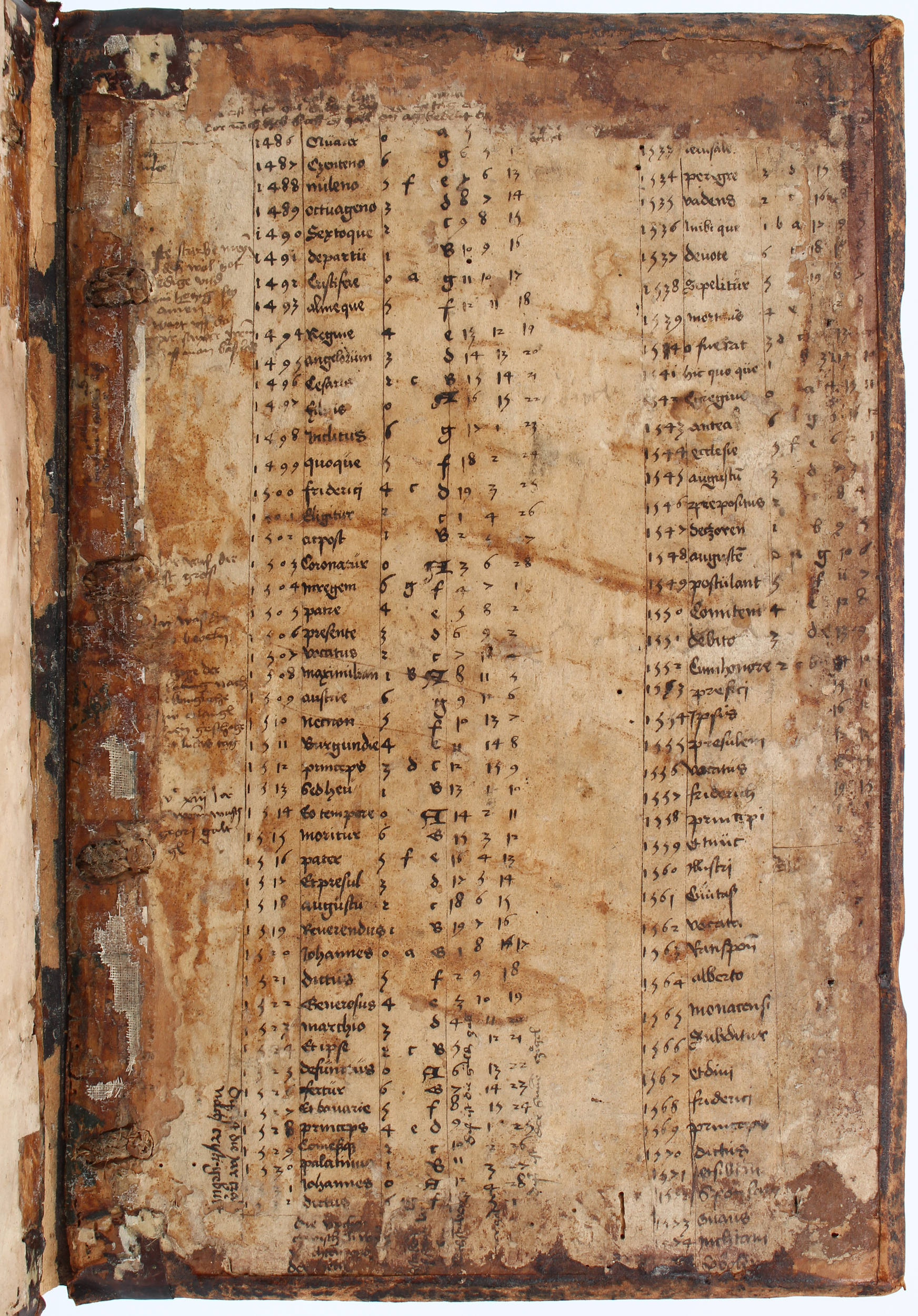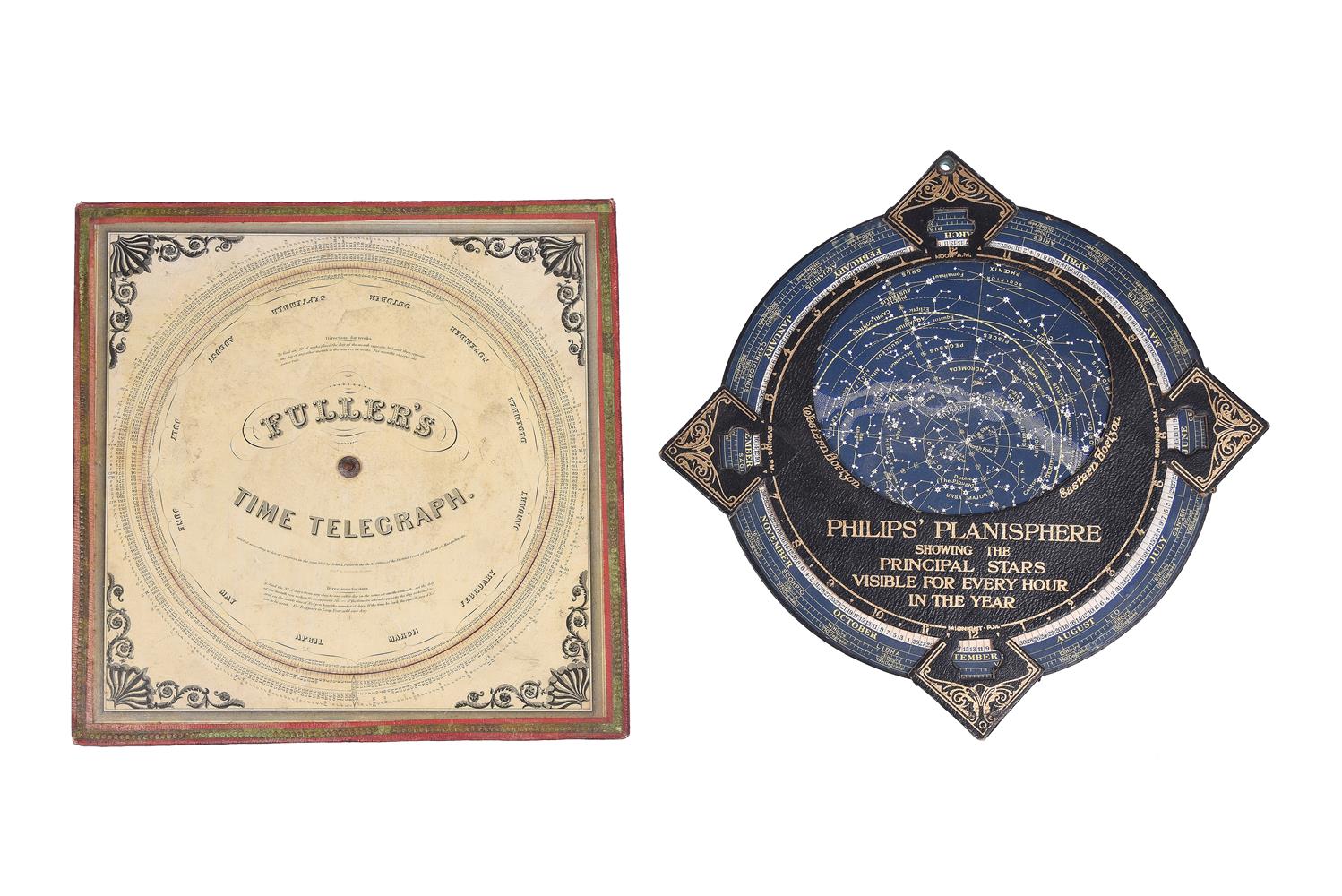CALENDAR for 1490 with computational tables, in Latin. Treatise on arithmetic, in Dutch, DECORATED AND DIAGRAMMATIC MANUSCRIPT ON VELLUM [northern Netherlands, 1490] 215 x 155mm. i+12 leaves: 1 8 and 2 4, 37 or 25 lines written in dark brown ink in a gothic bookhand between two verticals and on 37 or 25 horizontals ruled in plummet, justification: 135 x 105mm, the calendar table for each month on a grid formed of 22 vertical and 18 horizontal lines ruled in brown ink, justification: 140 x 100mm, headings in red mostly in large gothic textura quadrata script, initials (1-4 lines) in red, calendar tables in red and brown, diagram in red and brown (f.1v) (minor stains to first and last leaves, formerly pastedowns, a few smudges). 19th-century maroon morocco gilt. PROVENANCE: Richard L. Giveen: armorial bookplate CONTENT: Canon sive regula de inveniendo gradu ascendente figuraque celesti f.1r&v; schematic diagram of the heavens on 2 June 1490, with caption Figura celi tempore eclipsis medie lune anno Christi 1490 post meridiem secunde diei Junii hora nona minute 51 diebus equatis f.1v; Capitulum de ortu occasuque solis ac longitudine cuiusvis diei ac noctis f.1v; calendar table for each month of the year ff.2-7v; f.8 blank but ruled; f.9 blank; Tabula multiplicationis f.9v; Multiplicatio f.10; examples of multiplication f.10v; Divisio f.11; examples of division f. 11v; f.12 blank In the first part of the manuscript the calendar tables give for each day its number from the beginning of the year, the date of the month according to the modern system (rather than the roman system of counting from calends, nones and ides), the dominical letter, the important religious feasts, the tempus equationis dierum , the equatio 6 domorum , and the times of sunrise and sunset. The second part of the codex consists of two brief treatises on how to perform multiplication and division, each with a page of examples, and for multiplication a grid for finding the product of any two numbers up to 10 times 10. The manuscript must have been intended as a sort of ready reckoner, but its pristine condition suggests that it was seldom used.
CALENDAR for 1490 with computational tables, in Latin. Treatise on arithmetic, in Dutch, DECORATED AND DIAGRAMMATIC MANUSCRIPT ON VELLUM [northern Netherlands, 1490] 215 x 155mm. i+12 leaves: 1 8 and 2 4, 37 or 25 lines written in dark brown ink in a gothic bookhand between two verticals and on 37 or 25 horizontals ruled in plummet, justification: 135 x 105mm, the calendar table for each month on a grid formed of 22 vertical and 18 horizontal lines ruled in brown ink, justification: 140 x 100mm, headings in red mostly in large gothic textura quadrata script, initials (1-4 lines) in red, calendar tables in red and brown, diagram in red and brown (f.1v) (minor stains to first and last leaves, formerly pastedowns, a few smudges). 19th-century maroon morocco gilt. PROVENANCE: Richard L. Giveen: armorial bookplate CONTENT: Canon sive regula de inveniendo gradu ascendente figuraque celesti f.1r&v; schematic diagram of the heavens on 2 June 1490, with caption Figura celi tempore eclipsis medie lune anno Christi 1490 post meridiem secunde diei Junii hora nona minute 51 diebus equatis f.1v; Capitulum de ortu occasuque solis ac longitudine cuiusvis diei ac noctis f.1v; calendar table for each month of the year ff.2-7v; f.8 blank but ruled; f.9 blank; Tabula multiplicationis f.9v; Multiplicatio f.10; examples of multiplication f.10v; Divisio f.11; examples of division f. 11v; f.12 blank In the first part of the manuscript the calendar tables give for each day its number from the beginning of the year, the date of the month according to the modern system (rather than the roman system of counting from calends, nones and ides), the dominical letter, the important religious feasts, the tempus equationis dierum , the equatio 6 domorum , and the times of sunrise and sunset. The second part of the codex consists of two brief treatises on how to perform multiplication and division, each with a page of examples, and for multiplication a grid for finding the product of any two numbers up to 10 times 10. The manuscript must have been intended as a sort of ready reckoner, but its pristine condition suggests that it was seldom used.


.jpg)
.jpg)


.jpg)


Testen Sie LotSearch und seine Premium-Features 7 Tage - ohne Kosten!
Lassen Sie sich automatisch über neue Objekte in kommenden Auktionen benachrichtigen.
Suchauftrag anlegen